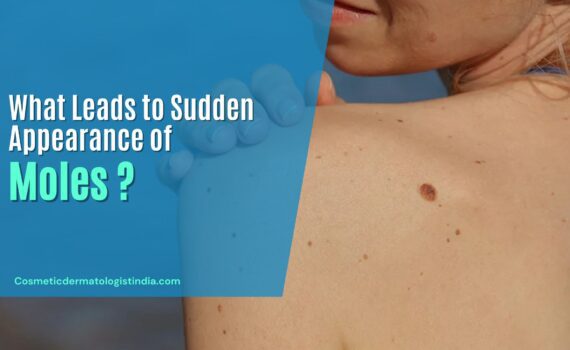
What Leads to the Sudden Appearance of Moles
Moles and warts are a common occurrence. Most people have them on their bodies (between 10-40) and they are considered very normal. Moles are also seen as the mark of beauty, and poets and lyricists have written about them. Celebrities such as Kareena Kapoor, Rekha, Marilyn Monroe, Cindy Crawford, and many more boast their moles as a mark of beauty and are recognized for them. Generally pigmented with black, moles can be pink or reddish brown. However, when the moles are more in numbers, appear in clusters, or are overgrowing, they can cause concern.
How are moles and warts formed?
The scientific name for moles is nevi (singular nevus). They are formed by the concentration of pigment-producing cells called melanocytes in the skin. Our skin has many pigment-producing cells that usually spread evenly on the skin and lend the skin its color. But if these pigments gather in one place, they form a mole. Usually, you will notice that most moles appear in the first 30 years of life, but they appear at later stages. Generally, more are nothing no worry about, and they are harmless marks on the body.
It is also normal for moles to change color and size as we age. People can have moles on any part of the body, such as the scalp, hands, feet, soles, palms, chest, back, fingers, and toes. There are different kinds of moles, and they are categorized based on their appearance, namely.
- Congenital moles: These are a type of birthmark and are present from the time of birth. They can be of any size, shape, and color and can be removed for cosmetic reasons. However, if they are bigger in size than 20cms then it is a risk that they will become malignant as the child grows. Also, if there are clusters of these moles around a more prominent mole, the risk of it being cancerous is high.
- Acquired moles or nevi: They are also called common moles. They usually start to appear during childhood or early adulthood. They can appear anywhere and are more visible on fair skin. They can be round or oval in shape, flat or raised, and are usually unchanging with smooth and distinct edges. In some cases, common moles can be hairy. If they are under 40 in number, then they are not a cause of work but anything more than 50 can be a slight risk but are rarely cancerous.
- Atypical moles: These are also known as dysplastic nevi and they can appear anywhere on the body except the face. They are usually irregular in shape and more significant in size. You can see them on the abdomen, back, neck, head, or scalp. Their appearance resembles melanoma (a type of skin cancer). Atypical moles usually have an uneven color tone with a dark-colored center. Since they look like melanoma, they should be checked regularly. Also, if these moles run in your family, they have a higher risk of skin cancer.
Warts are caused because of skin infections from the human papillomavirus (HPV), and they spread on contact, but they do not cause cancer.
What causes moles to appear suddenly?
Generally, moles are harmless, and most people go through life without doing anything about them. But if you notice more moles growing on your body, it is worth it to get it checked by a dermatologist. The reason is that new moles are more likely to become cancerous than old moles. Another red flag for problem moles is bleeding, oozing, or hurting. If you notice anything like this, immediately book an appointment with your dermatologist.
New moles might appear on your body because of over-exposure to UV rays, and the same harmful UV rays can cause the existing mole to change and even become cancerous. The harmful sunrays can damage your skin in many ways. Therefore, you must always protect your skin from the sun; otherwise, it increases the risk of melanoma. Melanoma is the worst form of skin cancer and is caused when the pigment-producing cells turn malignant and cause cancer by spreading. About 70.9% of melanomas are known to be caused because of new moles. Hence, dermatologists should check any mole that looks different from the ordinary.
A good dermatologist can detect the difference between a normal mole and melanoma and recommend suitable moles and wart removal treatment. Moles might also be caused because of
- Tanning or tanning bed use
- Genetics
- Family history of moles, especially the atypical nevi
- Increasing age
- Hormonal changes
- Fair skin and light or red hair
- Body’s normal response to Immunosuppressant drugs
- Use of antibiotics, hormones, or antidepressants
- Genetic changes
- Sunburns
- Organ transplants
Wearing perfumes and eating certain kinds of food does not cause the formation or growth of moles.
When to seek mole and wart removal treatment?
Both moles and warts can be easily removed. Daily it is not possible to notice changes in the moles. However, you should check your skin every month for any suspicious growth. There is a simple ABCDE guideline for checking suspicious moles.
It stands for asymmetrical shape. Therefore, if the mole is not symmetrical, it must be checked and treated.
B is for border irregularity: A regular mole has a smooth and defined shape, whereas a problem mole will have an irregular or scalloped border.
C is for color changes: If a mole changes color as it grows or has a varying shade of colors, it is not normal.
D is for the mole’s diameter: Any growing mole with a diameter of more than ¼ inch or 6mm must be treated for cancerous tendencies.
E stands for evolving: A qualified dermatologist should investigate a mole that has changed in size, shape, and color.
Early detection of moles can save you from skin cancer. Removing and treating moles before cancer spreads is easier and more effective. When detected early, melanoma can be treated successfully with low chances of relapse.
How to check for problem moles
Here is a simple checklist of things to do to check for symptoms of skin cancer in the moles
- Check your body in a full-length mirror at least once a week. Examine your body from all sides, including the back and armpits and back and buttocks.
- Check underarms, forearms, elbows, between your fingers, and front and back of the palms.
- Check your legs, feet soles, and between your toes.
- Check the back of your neck and even the scalp.
Note down any changes that you notice. For example, most melanomas start from the trunk area, i.e., the chest and back in men and on the legs in women.
Mole and wart removal treatments
Moles and wart removal treatments are simple outpatient procedures. The most common options for removing moles and warts include
- Skin excision by cutting the area of the mole: This procedure is done under local anesthesia.
- Skin resurfacing: This procedure is done using dermabrasion which gently removes the mole from the outer layers of the skin.
- Cryotherapy: the moles or warts can be frozen using liquid nitrogen.
- Laser ablation: The heat of laser light destroys or breaks up the moles or warts. This treatment can remove multiple moles at a time.
- Surgeries: When other treatment methods fail, the surgeon recommends surgery to remove moles and warts from the skin.
The treatment choice for removal depends on the type of mole and whether the tests show that the mole is cancerous.
Moles and wart removal treatment cost
The cost of wart and mole removal in Mumbai can vary depending on several factors such as the size, location, and number of moles or warts to be removed, the type of treatment or procedure used, the clinic or hospital where the procedure is performed, and the experience of the doctor or dermatologist performing the procedure.
Generally, the cost of wart and mole removal in Mumbai can range from as low as INR 500 to INR 10,000 per mole or wart, depending on the abovementioned factors. For example, if the mole or wart is small and only requires a simple procedure like laser removal, the cost could be as low as INR 500. On the other hand, if the mole or wart is large or located in a sensitive area, such as the face, the cost could be much higher.
It is important to note that the cost of wart and mole removal in Mumbai should not be the only factor to consider when choosing a clinic or dermatologist. Selecting a qualified and experienced dermatologist or doctor who can perform the procedure safely and effectively is essential. Additionally, it is recommended to consult with the doctor or dermatologist to determine the best course of treatment for the particular mole or wart in question.






